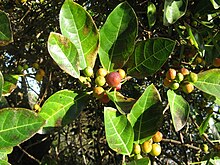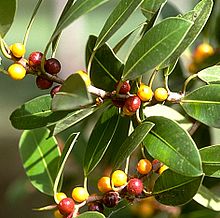Figs
| Figs | ||||||||||||
|---|---|---|---|---|---|---|---|---|---|---|---|---|

Common fig ( Ficus carica ) |
||||||||||||
| Systematics | ||||||||||||
|
||||||||||||
| Scientific name of the tribe | ||||||||||||
| Ficeae | ||||||||||||
| Gaudich. | ||||||||||||
| Scientific name of the genus | ||||||||||||
| Ficus | ||||||||||||
| L. |
The figs ( Ficus ) are the only genus of the tribe Ficeae within the plant family of the mulberry family (Moraceae). The best known species is the real fig ( Ficus carica ), the fruits of which are known as figs. The large genus ("large genus") consists of 750 to 1000 species of evergreen and deciduous trees, shrubs or climbing plants that are found in tropical and subtropical regions around the world. In frost-free areas, some species are planted for their decorative leaves or to provide shade in parks and gardens. Some species and their varieties are popular houseplants .
description
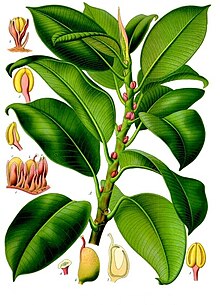
Vegetative characteristics
All Ficus species are woody plants: evergreen and deciduous trees , shrubs and climbing plants . There is white milky sap in the plants .
The mostly alternate leaves are mostly simple. A stipule can be seen, which arises from two fused stipules. Only rarely are these not grown together. The stipule protects the leaf bud and falls off when the leaf is unfolded.

Generative characteristics
The flowers are always unisexual and apetal (without petals). There are monoecious ( monoecious ) and gyno- dioecious but functionally dioecious ; dioecious segregated species with hermaphrodite flowers that function as males. Many flowers are sunk into an inflorescence , a jug-shaped, hollowed-out axis tissue . Only a small distal opening (ostiolum), narrowed by scales and bracts , remains as a connection to the outside. There can be three types of flowers in an inflorescence: male and fertile female flowers and sterile female (gall flowers). The male flowers have two to six sepals and usually one to three (rarely more) stamens . The fertile female flowers have no to six sepals and a free ovary with one or two unequal styles.
The fruits are seed-like achenes , usually enclosed in the enlarged, hollow flower base or surrounded by a fleshy perianth . It is a fruit association (achene fruit association), more precisely a sykonium , hypanthodium ( false fruit ; pseudocarp), since the many female flowers develop into achenes and are integrated into the fleshy, jar-shaped flower base.
The basic chromosome number is x = 13. Most species have diploidy , with a chromosome number of 2n = 26.
ecology
pollination
The pollination of all fig species is done by fig wasps (Agaonidae). Many fig species can only be pollinated by a very specific fig wasp species. The fig wasps penetrate the inflorescence through the distal opening, the ostiolum. They pollinate some fig blossoms and lay their eggs in others. The larvae hatch and feed on components of the fruit cluster until they develop into an imago . Afterwards, the flighty adult wasps hatch from the opening of the fruit cluster, look for a sexual partner and the cycle begins again.
Strangler figs
Some species of ficus are strangler figs. The seeds are eaten by birds and pass through the digestive tract undamaged. When they are excreted on the branch of a tree in the bird's droppings and stick there thanks to the mistletoe-like slimy seed coat, the seeds germinate on the branch. The fig plants grow right there; so it is first of all epiphytes . But their aerial roots grow down to the ground. When the roots reach the ground, the figs begin to grow faster and from now on they form many more aerial roots. They gradually enclose their support tree or host tree, which eventually dies, creating a cavity inside the strangler fig. The strangler fig also benefits from the nutrients released by the decomposition of the dead tree.
Some of the numerous types of strangler fig are:
- Tall fig ( Ficus altissima flower )
- Ficus aurea Nutt. , known in America as Florida strangler fig (Florida strangler fig)
- Ficus barbata Wall. , Bearded fig or bearded fig
- Ficus benghalensis L.
- Ficus burtt-davyi Hutch.
- Ficus citrifolia Mill. , Also called bearded fig
- Ficus craterostoma Warb. ex Mildbr. & Burret
- Ficus macrophylla Pers.
- Ficus obliqua G. Forest.
- Ficus tinctoria G. Forest.
- Ficus virens Aiton
- Ficus watkinsiana F.M.Bailey : Only three populations of this endemic are known in Queensland .

Food for animals
Since most Ficus species produce very many fruits , they are an important source of food for many animal species, including bats , primates and birds, and also for fruit-eating beetles such as the great rose beetle .
Systematics and distribution
The genus Ficus was established by Carl von Linné in Species Plantarum 2, 1753, p. 1059 and Genera Plantarum , 5th edition, 1754, p. 482. Lectotype species is Ficus carica L. The genus name Ficus is derived from the Latin word for the real fig , ficus , which is also related to the ancient Greek sykea . The German common name was also taken from Latin . Ficus is the only genus of the tribe Ficeae Gaudich. within the Moraceae family .
The genus Ficus contains 750 to 1000 species that thrive in tropical and subtropical regions around the world.


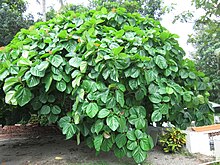







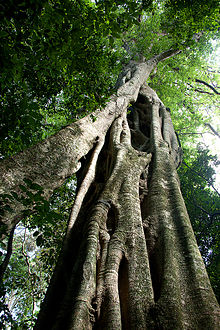


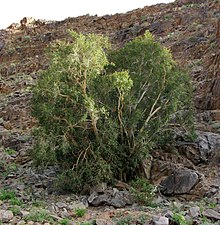


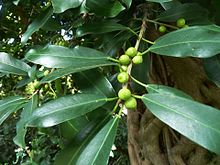

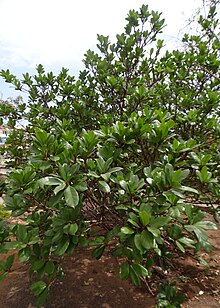



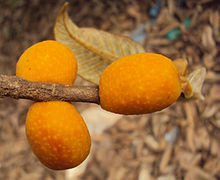


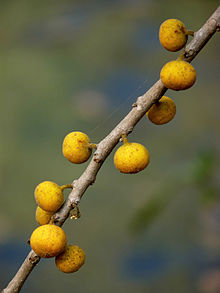

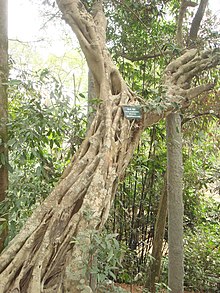


























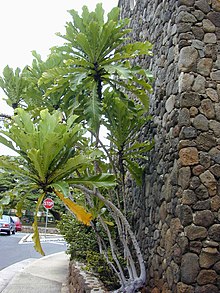

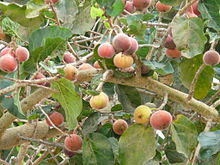
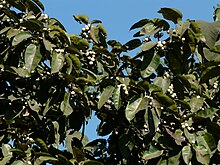
Inner structure
The genus of figs ( Ficus ) is divided into six sub-genera with sections, subsections and series:
- Subgenus Ficus : There are two sections:
- Section Ficus : There are two subsections:
- Subsection Ficus : It contains three types:
- Real fig ( Ficus carica L. ): There are subtaxa. She delivers the figs.
- Ficus iidaiana Wilson
- Ficus palmata Forsskål
- Subsection Frutescentiae : It contains about 25 species:
- Ficus abelii Miq.
- Ficus boninsimae Koidzumi
- Ficus chapaensis Gagnep.
- Mistletoe fig tree ( Ficus deltoidea Jack ): It is found in Thailand, Indonesia and Malaysia.
- Ficus edanoi Merr.
- Ficus erecta Thunb.
- Ficus filicauda Hand.Mazz.
- Ficus formosana Maxim.
- Ficus gasparriniana Miq.
- Ficus glareosa Elm.
- Ficus heteromorpha Hemsl.
- Ficus ischnopoda Miq.
- Ficus kofmanae C.C.Berg
- Ficus oleifolia King
- Ficus neriifolia J.E.Sm.
- Ficus pandurata Hance
- Ficus pedunculosa Miq.
- Ficus pustulata Elm.
- Ficus pyriformis Hook & Arn.
- Ficus stenophylla Hemsl.
- Ficus tannoensis Hayata
- Ficus tikoua Bureau
- Ficus trivia Corner
- Ficus variolosa Lindl. ex Benth.
- Ficus vaccinioides Hemsl. ex King
- Subsection Ficus : It contains three types:
- Section Eriosycea : There are two subsections:
- Subsection Auratae : It contains about 14 species:
- Ficus androchaete Corner
- Ficus aurata (Miq.) Miq.
- Ficus aureocordata Corner
- Ficus auricoma Corner ex CC Berg
- Ficus bruneiensis Corner
- Ficus brunneoaurata Corner
- Ficus diamantiphylla Corner
- Ficus endospermifolia Corner
- Ficus eumorpha Corner
- Ficus inaequipetiolata Merr.
- Ficus macilenta King
- Ficus paramorpha Corner
- Ficus setiflora Stapf
- Ficus subglabritepala C.C. Berg
- Subsection Eriosycea : It contains about 13 species:
- Ficus hirta Vahl
- Ficus lamponga Miq.
- Ficus langkokensis Drake
- Ficus litseifolia Corner
- Ficus mollissima Ridley
- Ficus oreophila Ridley
- Ficus padana Burm. f.
- Ficus ruficaulis Merr.
- Ficus schefferiana King
- Ficus simplicissima Lour.
- Ficus subfulva Corner
- Ficus tricolor Miq.
- Ficus tuphapensis Drake
- Subsection Auratae : It contains about 14 species:
- Section Ficus : There are two subsections:
- Subgenus Pharmacosycea (Miq.) Miq. : There are two sections:
- Pharmacosycea section : There are two subsections:
- Bergianae subsection : It contains about 14 species:
- Ficus adhatodifolia Schott
- Ficus apollinaris Dugand
- Ficus carchiana C.C.Berg
- Ficus crassiuscula Standl.
- Ficus dulciaria Dugand
- Ficus ernanii Carauta, Pederneiras, De Souza, Machado, Vianna Filho & Romaniuc : It was first described in 2012.
- Ficus gigantosyce Dugand
- Ficus insipida Willd. (Syn .: Ficus glabrata Kunth ): Also called Amatlbaum, Amate. The bark is used to make the paper-like writing material Amatl . It iswidespreadfrom northern Mexico through Central America to South America .
- Ficus mutisii Dugand
- Ficus obtusiuscula (Miq.) Miq.
- Ficus petenensis Lundell
- Ficus piresiana Vázquez Avila & CC Mountain
- Ficus pulchella Schott
- Ficus yoponensis Desv.
- Subsection Petenenses : It contains about eight species:
- Ficus ecuadorensis C.C. Berg
- Ficus guajavoides Lundell
- Ficus lacunata Kvitvik
- Ficus lapathifolia (Liebmann) Miq.
- Ficus macbridei Standl.
- Ficus maxima P. Miller
- Ficus rieberiana C.C.Berg
- Ficus tonduzii Standl.
- Bergianae subsection : It contains about 14 species:
- Section Oreosycea : There are two subsections:
- Subsection Glandulosae : It contains about 65 species:
- Ficus asperula Bureau
- Ficus auriculigera Bureau
- Ficus austrocaledonica Bureau
- Ficus balansana Bureau
- Ficus barraui Guillaum
- Ficus bubulia C.C.Berg
- Ficus campicola S.Moore
- Ficus carinata C.C. Berg
- Ficus cataractorum Bureau
- Ficus comptonii S.Moore
- Ficus crescentioides Bureau
- Ficus cretacea S.Moore
- Ficus dzumacensis Guillaumin
- Ficus edelfeltii King
- Edible fig ( Ficus edulis Bureau ), fruits are eaten.
- Ficus gigantifolia Merr.
- Ficus granatum G. Forest.
- Ficus gratiosa Corner
- Ficus habrophylla G.Been ex Seem.
- Ficus hadroneura Diels
- Ficus heteroselis Bureau
- Ficus hombroniana Corner
- Ficus hurlimannii Guillaumin
- Ficus ihuensis Summerh.
- Ficus illiberalis Corner
- Ficus kjellbergii Corner
- Ficus leiocarpa (Bureau) Warb.
- Ficus leptorhachis S.Moore
- Ficus lifouensis Corner
- Ficus longipes Warb.
- Ficus magnoliifolia Bl.
- Ficus magwana C.C.Berg
- Ficus maialis Bureau
- Ficus matanoensis C.C.Berg
- Ficus microtophora Corner
- Ficus mutabilis Bureau
- Ficus nervosa Heyne ex Roth
- Ficus nitidifolia Bureau
- Ficus novae-georgiae Corner
- Ficus oreadum S.Moore
- Ficus Otophora Corner & Guillaumin
- Ficus Otophoroides Corner
- Ficus pachysycia Corner
- Ficus pallidinervis Warb.
- Ficus pancheriana Bureau
- Ficus polyantha Warb.
- Ficus pseudojaca Corner
- Ficus pseudomangiferifolia Guillaumin
- Ficus pteroporum Guillaumin
- Ficus punctulosa Warb.
- Ficus racemigera Bureau
- Ficus rigidifolia Bureau
- Ficus saruensis C.C.Berg
- Ficus sclerosycia C.C.Berg
- Ficus semecarpifolia Warb.
- Ficus setulosa C.C. Berg
- Ficus smithii Horne ex Baker
- Ficus subcaudata C.C. Berg
- Ficus subnervosa corner
- Ficus subtrinervia Lauterb. & K.Schum.
- Ficus tanensis G.Benn. ex Seem.
- Ficus trachyleia Bureau
- Ficus versicolor Bureau
- Ficus vieillardiana Bureau
- Ficus webbiana Miq.
- Subsection Pedunculatae : It contains about nine species:
- Ficus albipila (Miq.) King
- Ficus ampana mountain
- Ficus assimilis Baker
- Ficus bataanensis Merrill
- Ficus callosa Willd.
- Ficus capillipes Gagnepain
- Ficus dicranostyla Mildbr.
- Ficus variifolia Warb.
- Ficus vasculosa Miq.
- Subsection Glandulosae : It contains about 65 species:
- Pharmacosycea section : There are two subsections:
- Subgenus Sycidium : There are two sections:
- Sycidium Section :
- It is not divided into subsections and contains around 81 species:
- Ficus ampelas Burman
- Ficus andamanica Corner
- Ficus arawaensis Corner
- Ficus aspera G. Forster
- Ficus asperifolia Miq.
- Ficus asperiuscula Kunth & CDBouché
- Ficus assamica Miq.
- Ficus badiopurpurea Diels
- Ficus balica Miq.
- Ficus bambusifolia sailor
- Ficus barclayana Miq.
- Ficus bojeri Baker
- Ficus brachyclada Baker
- Ficus carpentariensis Dixon
- Ficus capreifolia Delile
- Ficus chrysochaete Corner
- Ficus complexa corner
- Ficus conocephalifolia Ridley
- Ficus copiosa Steudel
- Ficus coronata spin
- Ficus coronulata Miq.
- Ficus cumingii Miq.
- Ficus cyrtophylla Miq.
- Ficus elmeri Merrill
- Ficus erinobotrya Corner
- Ficus eustephana Diels
- Ficus exasperata Vahl
- Ficus fiskei Elmer
- Ficus floresana C.C.Berg
- Ficus fraseri Miq.
- Ficus fulvopilosa Summerhayes
- Ficus godeffroyi Warb.
- Ficus goniophylla Corner
- Ficus greenwoodii Summerhayes
- Ficus gryllus Corner
- Ficus gul K.Schumann & Lauterbach
- Ficus henryi Diels
- Ficus hesperia Corner
- Ficus heterophylla L.
- Ficus heteropoda Miq.
- Ficus imbricata Corner
- Ficus lateriflora Vahl
- Ficus leptoclada Benth.
- Ficus leptodictya Diels
- Ficus leptogramma Corner
- Ficus longecuspidata Warb.
- Ficus macrorrhyncha K.Schum. & Lauterbach
- Ficus masonii Baker
- Ficus melinocarpa flower
- Ficus montana Burman
- Ficus myiopotamica C.C.Berg
- Ficus odorata Merr.
- Ficus oleracea Corner
- Ficus opposita Miq.
- Ficus pachyclada Baker
- Ficus phaeosyce K.Schum. & Lauterbach
- Ficus podocarpifolia Corner
- Ficus politoria Lam.
- Ficus porphyrochaete Corner
- Ficus praetermissa Corner
- Ficus primaria Corner
- Ficus pseudowassa Corner
- Ficus pygmaea here
- Ficus quercetorum Corner
- Ficus riedelii Miq.
- Ficus samoensis Summerhayes
- Ficus sandanakana C.C. Berg
- Ficus scabra G. Forster
- Ficus schumanniana Warb.
- Ficus sciaphila Corner
- Ficus scobina Benth.
- Ficus stellaris C.C. Berg
- Ficus storckii sailor
- Ficus subincisa J.E. Smith
- Ficus subsidens Corner
- Ficus tenuicuspidata Corner
- Ficus tonsa Miq.
- Ficus trachypison K.Schum. & Lauterbach
- Ficus tsiangii Corner
- Ficus ulmifolia Lam. : It occurs in the Philippines .
- Ficus uniauriculata Warb.
- Ficus wassa Roxb.
- It is not divided into subsections and contains around 81 species:
- Section palaeomorphs :
- It is not divided into subsections and contains about 29 species:
- Ficus anastomosans short
- Ficus armitii King
- Ficus aurita flower
- Ficus cauta Corner
- Ficus celebensis Corner
- Ficus corneriana C.C.Berg
- Ficus cuspidata flower
- Ficus funiculicaulis C.C. Berg
- Ficus gracillima Diels
- Ficus grewiifolia flower
- Ficus hemsleyana King
- Ficus heteropleura flower
- Ficus inaequifolia Elmer
- Ficus jaheriana Corner
- Ficus kuchinensis C.C.Berg
- Ficus lasiocarpa Miq.
- Ficus leptocalama Corner
- Ficus microsphaera Warb.
- Ficus midotis Corner
- Ficus obscura flower
- Cherry Fig ( Ficus parietal flower , Syn .: Ficus cerasiformis Desf., Ficus concentrica Hasselt ex Miq. , Ficus grandifolia Wall. Ex Miq. , Ficus junghuhniana Miq. , Ficus parietal var. Angustifolia Miq. , Ficus parietal var. Ovalis flower , Ficus parietal var. rufipila (Miq.) Miq. , Ficus parietal var. tabing (Miq.) Miq. , Ficus phlebophylla Miq. , Ficus rufipila Miq. , Ficus tabing Miq. ), fruits are eaten.
- Ficus pisifera Voigt
- Ficus rubrocuspidata Corner
- Ficus rubromidotis Corner
- Ficus sinuata Thunb.
- Ficus stipata King
- Ficus subulata flower
- Ficus tinctoria G. Forest. : It occurs in tropical Asia, China, Taiwan, Japan, Australia and on islands in the Pacific.
- Ficus uniglandulosa Miq.
- Ficus virgata flower
- It is not divided into subsections and contains about 29 species:
- Sycidium Section :
- Subgenus Sycomorus :
- Section Sycomorus : There are two subsections:
- Subsection Sycomorus : It contains about 14 species:
- Ficus botryoides Baker
- Ficus karthalensis C.C.Berg
- Ficus mauritiana Lam.
- Ficus mucuso Ficalho
- Ficus polyphlebia Baker
- Ficus racemosa L .: It occurs in tropical Asia, in China (Guizhou, Yunnan, Guangxi), Papua New Guinea and in Australia.
- Ficus sakalavarum Baker
- Ficus sur Forsk.
- Mulberry fig , also known as donkey fig, sycamor fig, sycamore ( Ficus sycomorus L. )
- Ficus tiliifolia Baker
- Ficus torrentium Perrier
- Ficus trichoclada Baker
- Ficus vallis-choudae Delile
- Ficus vogeliana (Miq.) Miq.
- Subsection Neomorphs : It contains about six species:
- Ficus auriculata Lour.
- Ficus hainanensis Merrill & Chun
- Ficus nodosa Teijsmann & Binnendijk
- Ficus robusta Corner
- Ficus semivestita Corner
- Ficus variegata flower
- Subsection Sycomorus : It contains about 14 species:
- Section adenosperm :
- It is not divided into subsections and contains about 19 types:
- Ficus adenosperma Miq.
- Ficus arbuscula Lauterbach & K.Schum.
- Ficus austrina Corner
- Ficus casearioides King
- Ficus comitis King
- Ficus endochaete Summerhayes
- Ficus erythrosperma Miq.
- Ficus funiculosa Corner
- Ficus indigofera Rechinger
- Ficus megaphylla Corner
- Ficus mollior Benth.
- Ficus pilulifera Corner
- Ficus saccata Corner
- Ficus subcuneata Miq.
- Ficus suffruticosa Corner
- Ficus trichocerasa Diels
- Ficus umbonata flower
- Ficus verticillaris Corner
- Ficus vitiensis sailor
- It is not divided into subsections and contains about 19 types:
- Bosscheria section :
- It is not divided into subsections and only contains two types:
- Ficus minahassae Teijsmann & De Vriese
- Ficus pungens flower
- It is not divided into subsections and only contains two types:
- Section Dammaropsis :
- It is not divided into subsections and contains about five types:
- Ficus dammaropsis Diels
- Ficus pseudopalma Blanco
- Ficus rivularis Merr.
- Ficus salomonensis Rechinger
- Ficus theophrastoides Seeman
- It is not divided into subsections and contains about five types:
- Hemicardia Section :
- It is not divided into subsections and contains only three types:
- Ficus koutumensis Corner
- Ficus prostrata Miq.
- Ficus semicordata J.E. Smith
- It is not divided into subsections and contains only three types:
- Section Papuasyce (Corner) CCMountain :
- It is not divided into subsections and contains only three types:
- Ficus itoana Diels
- Ficus microdictya Diels
- Ficus pritchardii Seeman
- It is not divided into subsections and contains only three types:
- Section: Sycocarpus : There are two subsections:
- Macrostyla subsection : it contains only two types:
- Ficus macrostyla Corner
- Ficus squamosa Roxb.
- Sycocarpus subsection : It contains about 92 species:
- Ficus adelpha Lauterbach & K.Schum.
- Ficus albomaculata C.C. Berg
- Ficus arfakensis King
- Ficus baccaureoides Corner
- Ficus beccarii King
- Ficus beguetensis Merr.
- Ficus bernaysii King
- Ficus biakensis C.C.Berg
- Ficus boanensis C.C. Berg
- Ficus botryocarpa Miq.
- Ficus bougainvillei Corner
- Ficus calcarata Corner
- Ficus calopilina Diels
- Ficus carpenteriana Elmer
- Ficus cassidyana Elmer
- Ficus cereicarpa Corner
- Ficus congesta Roxb.
- Ficus conglobata King
- Ficus cryptosycea Corner
- Ficus cuneata (Miq.) Miq.
- Ficus cynarioides Corner
- Ficus d'albertisii King
- Ficus decipiens flower
- Ficus dimorpha King
- Ficus dissipata Corner
- Ficus fistulosa flower
- Ficus flagellaris Diels
- Ficus francisci Winkler
- Ficus geocarpa Miq.
- Ficus geocharis Corner
- Ficus gilapong Miq.
- Ficus griffithii Miq.
- Ficus hahliana Diels
- Ficus hispida L.
- Ficus hypogaea King
- Ficus iodotricha Diels
- Ficus immanis Corner
- Ficus ixoroides Corner
- Ficus lancibracteata Corner
- Ficus latimarginata Corner
- Ficus lepicarpa Corner
- Ficus limosa C.C. Berg
- Ficus linearifolia Elmer
- Ficus longibracteata Corner
- Ficus macrothyrsa Corner
- Ficus manuselensis C.C.Berg
- Ficus megaleia Corner
- Ficus morobensis C.C. Berg
- Ficus multistipularis Merr.
- Ficus nana Corner
- Ficus nota (Blanco) Merr. : It occurs in Malaysia and the Philippines.
- Ficus novahibernica
- Ficus obpyramidata King
- Ficus pachyrrhachis Lauterbach & K.Schum.
- Ficus papuana Corner
- Ficus parvibracteata Corner
- Ficus pleyteana Corner
- Ficus porrecta (Corner) CC Mountain
- Ficus profusa Corner
- Ficus remifolia Corner ex CC Berg
- Ficus ribes flower
- Ficus rubrosyce C.C.Berg
- Ficus satterthwaitei Elmer
- Ficus saurauioides Diels
- Ficus scaposa Corner
- Ficus schwarzii Koorders
- Ficus scopulifera C.C.Berg
- Ficus scortechinii King
- Ficus septica Burman f.
- Ficus serraria Miq.
- Ficus stolonifera King
- Ficus subcongesta Corner
- Ficus sublimbata Corner
- Ficus subterranea Corner
- Ficus sulcata Elmer
- Ficus tanypoda Corner
- Ficus tarennifolia Corner
- Ficus ternatana (Miq.) Miq.
- Ficus treubii King
- Ficus tunicata Corner
- Ficus uncinata (King) Beccari
- Ficus virescens Corner
- Ficus vrieseana Miq.
- Macrostyla subsection : it contains only two types:
- Section Sycomorus : There are two subsections:
- Subgenus Synoecia : It is divided into two sections:
- Section Kissosycea :
- It is not divided into subsections and contains around 28 types:
- Ficus allutacea flower
- Ficus apiocarpa (Miq.) Miq.
- Ficus barba-jovis Corner
- Ficus carrii Corner
- Ficus cataupi Elmer
- Ficus cavernicola C.C. Berg
- Ficus densechini Corner
- Ficus detonsa Corner
- Ficus diandra Corner
- Ficus disticha flower
- Ficus distichoidea Diels
- Ficus diversiformis Miq.
- Ficus grandiflora Corner
- Ficus gymnorygma Summerhayes
- Ficus hederacea Roxb.
- Ficus peninsula Elmer
- Ficus phatnophylla Diels
- Ficus punctata Thunb.
- Ficus ruginervia Corner
- Ficus sarawakensis Corner
- Ficus scratchleyana King
- Ficus singalana King
- Ficus sohotonensis C.C.Berg
- Ficus submontana C.C. Berg
- Ficus trachycoma Miq.
- Ficus tulipifera Corner
- Ficus warburgii Elmer
- It is not divided into subsections and contains around 28 types:
- Section Rhizocladus : There are four subsections:
- Plagiostigma subsection : It contains about eight types:
- Ficus anserina (Corner) CC Mountain
- Ficus impressa Benth.
- Ficus guizhouensis S.S.Chang
- Ficus pubigera (Miq.) Miq.
- Climbing fig ( Ficus pumila ) L .: It occurs in China, Japan, Taiwan and Vietnam.
- Ficus polynervis S.S.Chang
- Ficus sarmentosa J.E. Smith
- Ficus yunnanensis S.S.Chang
- Subsection: Pogonotrophs : There is only one type:
- Ficus laevis flower
- Subsection: Punctulifoliae : It contains about 24 species:
- Ficus ampulliformis Corner
- Ficus araneosa King
- Ficus baeuerlenii King
- Ficus camptandra Diels
- Ficus colobocarpa (Corner) CC Mountain
- Ficus devestiens Corner
- Ficus excavata King
- Ficus floccifera Diels
- Ficus fuscata Summerhayes
- Ficus hypobrunnea Corner
- Ficus insculpta Summerhayes
- Ficus jacobsii C.C. Berg
- Ficus lanata flower
- Ficus odoardii King
- Ficus ovatacuta Corner
- Ficus oxymitroides Corner
- Ficus pantoniana King
- Ficus pendens corner
- Ficus recurva flower
- Ficus sabahana Kochummen
- Ficus sageretina Diels
- Ficus sagittata Vahl
- Ficus spiralis Corner
- Ficus supperforata Corner
- Ficus villosa flower
- Subsection Trichocarpeae : It contains about ten species:
- Ficus bakeri Elmer
- Ficus cinnamomea Corner
- Ficus hypophaea Worse
- Ficus jimiensis C.C.Berg
- Ficus nasuta Summerhayes
- Ficus perfulva Merrill
- Ficus phaeobullata Corner
- Ficus pleiadenia Diels
- Ficus supfiana Worse
- Ficus trichocarpa flower
- Plagiostigma subsection : It contains about eight types:
- Section Kissosycea :
- Subgenus Urostigma (Endl.) Miq. :
- Americana Section :
- It is not divided into subsections and contains around 110 species:
- Ficus acreana C.C. Berg
- Ficus albert-smithii Standl.
- Ficus amazonica (Miq.) Miq.
- Ficus americana Aubl. : It iswidespreadfrom Mexico through Central America and on the Caribbean islands to South America .
- Ficus andicola Standl.
- Ficus aripuanensis C.C. Berg & F.Kooy
- Ficus aurea Nutt. : It occurs in Florida , Mexico, Guatemala, Honduras, Nicaragua, Costa Rica, Panama and on islands in the Caribbean.
- Ficus bahiensis C.C. Berg & Carauta
- Ficus blepharophylla Vázquez Avila
- Ficus boliviana C.C. Berg
- Ficus brevibracteata W.Burger
- Ficus brittonii Boldingh
- Ficus broadwayi Urban
- Ficus bullenei I.M.Johnston
- Ficus caballina Standl.
- Ficus cahuitensis C.C.Berg
- Ficus caldasiana Dugand
- Ficus calimana Dugand
- Ficus calyptroceras (Miq) Miq.
- Ficus carautana Emygdio
- Ficus casapiensis (Miq.) Miq.
- Ficus castellviana Dugand
- Ficus catappifolia Kunth & CDBouché
- Ficus cervantesiana Standl. & LOWilliams
- Ficus cestrifolia Schott
- Ficus chaparensis C.C. Berg & Villavicencio
- Ficus christianii Carauta
- Ficus citrifolia Mill . : It iswidespreadin Florida , from Mexico to Central America and on the Caribbean islands to South America.
- Ficus coerulescens (Rusby) Rossberg
- Ficus colubrinae Standl.
- Ficus costaricana (Liebmann) Miq.
- Ficus cotinifolia Kunth
- Ficus cotopaxiensis C.C.Berg
- Ficus crassinervia Willd.
- Ficus cremersii C.C. Berg
- Ficus crocata (Miq.) Miq.
- Ficus cuatrecasana Dugand
- Ficus davidsonii Standl.
- Ficus dendrocida Kunth
- Ficus donnell-smithii Standl.
- Ficus duartei C.C. Berg & Carauta
- Ficus duckeana C.C. Berg & Ribeiro
- Ficus dugandii Standl.
- Ficus eliadis Standl.
- Ficus enormis (Miq.) Miq.
- Ficus eximia Schott
- Ficus goiana C.C. Berg , Carauta & AFPMachado
- Ficus gomelleira Kunth & CDBouché
- Ficus gramalotensis Dugand
- Ficus greiffiana Dugand
- Ficus guatiquiae Dugand
- Ficus guianensis Desvaux
- Ficus hartwegii (Miq.) Miq.
- Ficus hatschbachii C.C. Berg & Carauta
- Ficus hebetifolia Dugand
- Ficus hirsuta Schott
- Ficus holosericea Schott
- Ficus jacobii Vázquez Avila
- Ficus krukovii Standl.
- Ficus lagoensis C.C. Berg & Carauta
- Ficus laureola C.C. Berg & Carauta
- Ficus lauretana Vázquez Avila
- Ficus leiophylla C.C. Berg
- Ficus longifolia Schott
- Ficus luschnathiana (Miq.) Miq.
- Ficus malacocarpa Standl.
- Ficus mantana C.C.Berg
- Ficus mariae C.C. Berg, Emygdio & Carauta
- Ficus maroma Castellanos
- Ficus maroniensis Benoist
- Ficus mathewsii (Miq.) Miq.
- Ficus matiziana Dugand
- Ficus membranacea C. Wright
- Ficus mollicula Pittier
- Ficus nymphaeifolia Mill.
- Ficus obtusifolia Kunth : It is distributed from Mexico to Central and South America.
- Ficus osensis C.C.Berg
- Ficus pakkensis Standl.
- Ficus pallida Vahl
- Ficus paludica Standl.
- Ficus panurensis Standl.
- Ficus paraensis (Miq.) Miq.
- Ficus pertusa L. f.
- Ficus petiolaris Kunth
- Ficus popenoei Standl.
- Ficus richteri Dugand
- Ficus rimicana C.C.Berg
- Ficus romeroi Dugand
- Ficus roraimensis C.C. Berg
- Ficus salicaria C.C. Berg
- Ficus schippii Standl.
- Ficus schultesii Dugand
- Ficus schumacheri (Liebmann) Griseb.
- Ficus sphenophylla Standl.
- Ficus subandina Dugand
- Ficus subapiculata (Miq.) Miq.
- Ficus tepuiensis C.C. Berg & Simonis
- Ficus tequendama Dugand
- Ficus tovarensis Pittier
- Ficus trapezicola Dugand
- Ficus trianae Dugand
- Ficus trigona L. f.
- Ficus trigonata L .: It occurs on the Caribbean islands of Cuba , Hispaniola , Dominica , Puerto Rico , Montserrat , Martinique , Guadeloupe and on the Virgin Islands .
- Ficus turrialbana W.Burger
- Ficus ursina Standl.
- Ficus velutina Willd.
- Ficus venezuelensis C.C. Berg
- Ficus vittata Vázquez Avila
- Ficus ypsilophlebia Dugand
- Ficus zarzalensis Standl.
- Ficus zuliensis C.C. Berg & Simonis
- It is not divided into subsections and contains around 110 species:
- Section Galoglychia : There are six subsections:
- Caulocarpae subsection : It contains about twelve species:
- Ficus artocarpoides Warb.
- Ficus bizanae Hutch. & Burtt-Davy
- Ficus bubu Warb.
- Ficus chirindensis C.C. Berg
- Ficus dryepondtiana De Wild.
- Ficus modesta F. White
- Ficus ottoniifolia (Miq.) Miq.
- Ficus ovata Vahl
- Ficus polita Vahl
- Ficus sansibarica Warb.
- Ficus tremula Warb.
- Ficus umbellata Vahl
- Subsection Chlamydodorae : It contains about 17 species:
- Ficus amadiensis De Wild
- Ficus antandronarum (Perrier) Mountain
- Ficus burtt-davyi Hutch.
- Ficus calyptrata Vahl
- Ficus craterostoma Mildbr. & Burret
- Ficus faulkneriana C.C.Berg
- Ficus fischeri Mildbr. & Burret
- Ficus ilicina (special) Miq.
- Ficus kamerunensis Mildbr. & Burret
- Ficus linqua De Wild. & T.Durand
- Natal fig, barkcloth fig, bark-cloth fig, common wild fig, fire-stick, strangler fig, Figuier de Natal, mlandege, Mlumba, utambe, kiditi, amannyedyua, akabofui, eduro, endjuuque, parafi din tera, pov di dalgu, tarafi din tera, ituba, mutuba, laru, khumusonya, kumuluba, tera, kiryanyonyi, mugaire, omugaire, omukosi, soto foro, sotokuro, ekerae, ngagutuo, uchime, mutooma, Kachere Tree ( Ficus natalensis Hochst. ): She is in Africa widespread and is of great symbolic importance, especially in Malawi.
- Ficus persicifolia Warb.
- Ficus petersii Warb.
- Ficus psilopoga Ficahlo
- Ficus reflexa Thunb.
- Ficus rokko Warb. & Schweinf.
- Ficus thonningii flower : It occurs from tropical to southern Africa.
- Subsection Crassicostae : It contains about eight species:
- Ficus adolfi-friderici Mildbr.
- Ficus burretiana Hutch.
- Ficus elasticoides De Wild.
- Ficus leonensis Hutch.
- Ficus louisii Boutique & J.Léonard
- Ficus oreodryadum Mildbr.
- Ficus pseudomangifera Hutch.
- Ficus usambarensis Warb.
- Subsection Cyathistipulae : It contains about 19 species:
- Ficus abscondita C.C. Berg
- Ficus ardisioides Warb.
- Ficus barteri Sprague
- Ficus conraui Warb.
- Ficus crassicosta Warb.
- Ficus cyathistipula Warb. : It occurs in tropical Africa.
- Ficus cyathistipuloides De Wild.
- Ficus densistipulata De Wild.
- Violin fig ( Ficus lyrata Warb. )
- Ficus oresbia C.C. Berg
- Ficus pachyneura C.C. Berg
- Ficus preussii Warb.
- Ficus sagittifolia Mildbr. & Burret
- Ficus scassellatii Pamp.
- Ficus scott-elliotii Mildbr. & Burret
- Ficus subcostata De Wild.
- Ficus subsagittifolia C.C.Berg
- Ficus tesselata Warb.
- Ficus wildemaniana De Wild. & T.Durand
- Galoglychia subsection : it contains only three species:
- Ficus chlamydocarpa Mildbr. & Burret
- Zulufeige ( Ficus lutea Vahl , Syn .: Ficus vogelii (Miq.) Miq. ): It is distributed from tropical to southern Africa, on Madagascar, the Comoros and Seychelles .
- Ficus saussureana DC.
- Subsection Platyphyllae : It contains about 18 species:
- Ficus abutilifolia (Miq.) Miq.
- Ficus bivalvata Perrier
- Ficus bussei Mildbr. & Burret
- Ficus glumosa Delile
- Ficus grevei Baill.
- Ficus jansii boutique
- Ficus marmorata Baker
- Ficus muelleriana mountain
- Ficus nigropunctata Mildbr. & Burret
- Ficus platyphylla Delile
- Ficus populifolia Vahl
- Ficus recurvata De Wildeman
- Ficus rubra Vahl
- Ficus stuhlmannii Warb.
- Ficus tettensis Hutch.
- Ficus trichopoda Baker
- Ficus vasta Forsk.
- Ficus wakefieldii Hutch.
- Caulocarpae subsection : It contains about twelve species:
- Malvanthera Section : There are three subsections:
- Subsection Hesperidiiformes : It is divided into three series and contains about twelve species:
- Glandiferae series : it contains only three species:
- Ficus Baola C.C.Berg
- Ficus glandifera Summerhayes
- Ficus rhizophoriphylla King
- Hesperidiiformes series : it contains only two types:
- Ficus hesperidiiformis King
- Ficus sterrocarpa Diels
- Xylosyciae series : It contains about four species:
- Ficus augusta Corner
- Ficus heteromeka Corner
- Ficus mafuluensis Summerhayes
- Ficus xylosycia Diels
- Glandiferae series : it contains only three species:
- Malvantherae subsection : it contains only two species:
- Large-leaved fig , also known as the Australian rubber tree ( Ficus macrophylla Pers. ): It occurs in the Australian states of Queensland and New South Wales .
- Ficus pleurocarpa F. Mueller
- Subsection Platypodeae : It is divided into four series and contains about twelve species:
- Crassipes series : it contains only two types:
- Ficus crassipes F.M.Bailey
- Ficus destruens C.T.White : It is only found in Queensland.
- Eubracteatae series : There is only one species:
- Ficus triradiata Corner
- Obliquae series : It contains about five types:
- Ficus cerasicarpa D.J.Dixon
- Ficus lilliputiana D.J.Dixon
- Ficus obliqua G. Forest. : It occurs in the Moluccas , in Irian Jaya , Papua New Guinea, in New Caledonia , on the Solomon Islands , Fiji Islands , on Niue , Samoa , Tonga and in the Australian states of New South Wales and Queensland.
- Ficus platypoda Miq. : It occurs in the Australian states of New South Wales, Queensland, South Australia , Western Australia and in the Northern Territory.
- Ficus subpuberula Corner
- Series: Rubiginosae : It contains about four species:
- Ficus atricha D.J.Dixon
- Ficus brachypoda (Miq.) Miq.
- Ficus rubiginosa Vent. : It occurs in the Australian states of New South Wales and Queensland.
- Ficus watkinsiana F.M.Bailey : It occurs in the Australian states of New South Wales and Queensland.
- Crassipes series : it contains only two types:
- Subsection Hesperidiiformes : It is divided into three series and contains about twelve species:
- Urostigma Section : There are two subsections:
- Subsection Conosycea : It contains about 64 species:
- Ficus acamptophylla Miq.
- Tall fig ( Ficus altissima flower ): It occurs in India , Nepal , Bhutan , Myanmar , Thailand , Vietnam , Malaysia , Indonesia , the Philippines and in the Chinese provinces of Guangdong , Yunnan , Guangxi and Hainan .
- Ficus annulata flower
- Ficus archboldiana Summerhayes
- Ficus balete Merr.
- Ficus beddomei King
- Banyan fig , also called the banyan tree or Bengali fig ( Ficus benghalensis L. ): It occurs in India and Pakistan .
- Weeping fig ( Ficus benjamina L. )
- Ficus binnendijkii Miq.
- Ficus borneensis boiling hum
- Ficus bracteata Miq.
- Ficus calcicola Corner
- Ficus callophylla flower
- Ficus chrysolepis Miq.
- Ficus consociata flower
- Ficus cordatula Merr.
- Ficus corneri boiling hum
- Ficus costata Aiton
- Ficus crassiramea Miq.
- Ficus cucurbitina King
- Ficus curtipes Corner
- Ficus dalhouseae Miq.
- Ficus delosyce Corner
- Ficus depressa flower
- Ficus drupacea Thunb. : It occurs in tropical Asia, China and Queensland.
- Ficus dubia King
- Rubber tree ( Ficus elastica Roxb. Ex Hornem. )
- Ficus fergusonii (King) Worthington
- Ficus forstenii Miq.
- Ficus glaberrima flower
- Ficus globosa flower
- Ficus hillii F.M.Bailey
- Ficus humbertii C.C. Berg
- Ficus involucrata flower
- Ficus juglandiformis King
- Ficus kerkhovenii Valeton
- Ficus kochummeniana C.C.Berg
- Ficus kurzii King
- Ficus lawesii King
- Ficus lowii King
- Ficus maclellandii King
- Ficus menabeensis Perrier
- Chinese fig , or laurel fig , called Indian laurel, ( Ficus microcarpa L. f. , Syn .: Ficus retusa auct., Ficus nitida auct., Ficus retusiformis H.Lév. )
- Ficus microsycea Ridley
- Ficus miqueliana C.C. Berg
- Ficus mollis Vahl
- Ficus pallescens (Weiblen) CC Berg
- Ficus paracamptophylla Corner
- Ficus patellata Corner
- Ficus pellucidopunctata Griffith
- Ficus pharangensis Gagnepain
- Ficus pisocarpa flower
- Ficus pubilimba Miq.
- Ficus retusa L.
- Ficus rigo F.M.Bailey
- Ficus spathulifolia Corner
- Ficus stricta (Miq.) Miq.
- Ficus subcordata flower
- Ficus subgelderi Corner
- Ficus sumatrana (Miq.) Miq.
- Ficus sundaica flower
- Ficus talbotii King
- Ficus trimenii King
- Ficus tristaniifolia Corner
- Ficus xylophylla Miq.
- Urostigma subsection : It contains about 25 species:
- Ficus amplissima J.E. Smith
- Ficus arnottiana (Miq.) Miq.
- Ficus cardiophylla Merr.
- Ficus caulocarpa Miq.
- Ficus concinna Miq.
- Ficus cordata Thunb.
- Ficus cupulata Haines
- Ficus densifolia Miq.
- Ficus geniculata short
- Ficus hookeriana Corner
- Ficus ingens (Miq.) Miq.
- Ficus lacor Buchanan-Hamilton
- Ficus madagascariensis C.C. Berg
- Ficus orthoneura Lév. & Vaniot
- Ficus prolixa G.Forst. : It occurs in the Fiji Islands , Vanuatu , New Caledonia , the Pitcairn Islands , French Polynesia , the northern Mariana Islands and Micronesia .
- Ficus prasinicarpa Elmer
- Poplar fig , also called buddha tree, bodhi tree, bob tree, pepul tree ( Ficus religiosa L. )
- Ficus rumphii flower
- Ficus salicifolia (Vahl) mountain
- Ficus saxophila flower
- Ficus subpisocarpa Gagnepain
- Ficus superba Miq.
- Ficus tsjahela Burman
- Ficus verruculosa Warb.
- also Bengal strangler fig, called Java fig ( Ficus virens Aiton ): It occurs in tropical Asia, in China, Japan, Taiwan and in Australia.
- Subsection Conosycea : It contains about 64 species:
- Americana Section :
use
Use in the kitchen
The figs of some kinds are eaten. The best known is the common fig ( Ficus carica ). For example, the figs of Ficus macrophylla and Ficus palmata are also used .
Figs sold in Austria are usually dried and brown. Commercial form used to be rings to which the axially pressed fruits were threaded onto a biogenic fiber and knotted. Today, 250 g of figs are pressed into an elongated brick, wrapped in cellophane and placed in a wooden box or sturdy cardboard box. In most cases, a 4–8 mm short stalk remains on the fruit until it is eaten, which is not eaten but prevents germs from penetrating during the drying process.
Supplier countries are Turkey and Italy, 2018 are, however, already in Vienna- Simmering cultivated figs.
Use as a medicinal plant
The medicinal properties of the common fig ( Ficus carica ) were investigated.
Ornamental plant in parks and gardens
Many species are used as ornamental plants in parks and gardens.

Ornamental plant in rooms
Some Ficus species and their varieties are used as ornamental plants in rooms (selection):
- Weeping fig, also called Benjamin Ficus ( Ficus benjamina ): Often offered in many varieties (for example Ficus benjamina 'Natasja').
- Mistletoe fig tree ( Ficus deltoidea ): This species produces fruits easily. Robust type in heated rooms.
- Rubber tree ( Ficus elastica ): Previously very popular houseplant, which is now being offered more frequently in various varieties. Very robust type.
- Violin fig ( Ficus lyrata ): A large-leaved, sparsely growing species. Very easy to look after in heated rooms.
- Chinese fig , also called laurel fig or Indian laurel ( Ficus microcarpa , Syn .: Ficus retusa ): Robust species that can also cope with cooler rooms, for example as an indoor bonsai .
- Climbing fig ( Ficus pumila ): A small-leaved species that climbs with adhesive roots. It is offered as a ground cover or climbing on moss sticks.
Due to their good adaptation to the climate of the living area, different species are suitable as indoor bonsai .
literature
- E. Bolay: ecology of strangler figs. In: Biology in Our Time . Volume 2, 1977, pp. 55-58.
- E. Bolay: Figs and strangler figs. In: Pharmacy in our time . Volume 8, 4, 1979, pp. 97-112.
- E. Bolay: A Strangler Fig (Ficus benjamina L.) - Example of a teaching unit on the subject of epiphytism and parasitism. In: Science in Class - Biology. Volume 7, 2, 1981, pp. 272-279.
- Zhengyi Wu, Zhe-Kun Zhou, Michael G. Gilbert: Moraceae. : Ficus , p. 37 - online with the same text as the printed work , In: Wu Zhengyi, Peter H. Raven, Deyuan Hong (Eds.): Flora of China. Volume 5: Ulmaceae through Basellaceae. Science Press and Missouri Botanical Garden Press, Beijing and St. Louis, December 19, 2003, ISBN 1-930723-27-X .
- Richard P. Wunderlin: Moraceae. : Ficus - the same text online as the printed work , In: Flora of North America Editorial Committee (Ed.): Flora of North America North of Mexico. Volume 3: Magnoliidae and Hamamelidae. Oxford University Press, New York and Oxford, 1997, ISBN 0-19-511246-6 .
Individual evidence
- ^ Jules Janick: Horticultural Reviews. Vol. 34, Wiley, 2008, ISBN 978-0-470-17153-0 , p. 165.
- ↑ Zhengyi Wu, Zhe-Kun Zhou, Michael G. Gilbert: Moraceae. : Ficus , p. 37 - online with the same text as the printed work , In: Wu Zhengyi, Peter H. Raven, Deyuan Hong (Eds.): Flora of China. Volume 5: Ulmaceae through Basellaceae. Science Press and Missouri Botanical Garden Press, Beijing and St. Louis, December 19, 2003, ISBN 1-930723-27-X .
- ↑ Richard P. Wunderlin: Moraceae. : Ficus - the same text online as the printed work , In: Flora of North America Editorial Committee (Ed.): Flora of North America North of Mexico. Volume 3: Magnoliidae and Hamamelidae. Oxford University Press, New York and Oxford, 1997, ISBN 0-19-511246-6 .
- ↑ D. Ohri, TN Khoshoo: Nuclear DNA contents in the genus Ficus (Moraceae). In: Plant Systematics and Evolution , Volume 156, Issue 1, 1987, pp. 1-4. JSTOR 23673783 , doi : 10.1007 / BF00937196
- ↑ Ficus carica - structure of the inflorescence and pollination mechanism - data sheet of the University of Marburg: http://online-media.uni-marburg.de/biologie/nutz Pflanzen/sylvia/interest.htm ( Memento from March 4, 2016 in the Internet Archive )
- ↑ Linné 1753: scanned in at biodiversitylibrary.org
- ^ Ficus at Tropicos.org. Missouri Botanical Garden, St. Louis, Retrieved May 21, 2017.
- ↑ Helmut Genaust: Etymological dictionary of botanical plant names. 3rd, completely revised and expanded edition. Birkhäuser, Basel / Boston / Berlin 1996, ISBN 3-7643-2390-6 , p. 248 (reprint ISBN 3-937872-16-7 ).
- ↑ a b c d e f g h i j k l m n o p q r s t u v w x y z aa ab ac ad ae af ag ah ai aj ak al am an ao ap aq ar as at au av aw ax ay az ba bb bc bd be bf bg bh bi bj bk bl bm bn bo bp bq br bs bt bu bv bw bx by bz ca cb cc cd ce cf cg ch ci cj ck cl cm cn co cp cq cr cs ct cu cv cw cx cy cz da db dc dd de df dg dh di dj dk dl dm dn do dp dq dr ds dt du dv dw dx dy dz ea eb ec ed ee ef eg eh ei ej ek el em en eo ep eq er es et eu ev ew ex ey ez fa fb fc fd fe ff fg fh fi fj fk fl fm fn fo fp fq fr fs ft fu fv fw fx fy fz ga gb gc gd ge gf gg gh gi gj gk gl gm gn go gp gq gr gs gt gu gv gw gx gy gz ha hb hc hd he hf hg hh hi hj hk hl hm hn ho hp hq hr hs ht hu hv hw hx hy hz ia ib ic id ie if ig ih ii ij ik il im in io ip iq ir is it iu iv iw ix iy iz ja jb jc jd je jf jg jh ji jj jk jl jm jn jo jp jq jr js jt ju jv jw jx jy jz ka kb kc kd ke kf kg kh ki kj kk kl km kn ko kp kq kr ks kt ku kv kw kx ky kz la lb lc ld le lf lg lh li lj lk ll lm ln lo lp lq lr ls lt lu lv lw lx ly lz ma mb mc m d me mf mg mh mi mj mk ml mm mn mo mp mq mr ms mt mu mv mw mx my mz na nb nc nd ne nf ng nh ni nj nk nl nm nn no np nq nr ns nt nu nv nw nx ny nz oa ob oc od oe of og oh oi oj ok ol om on oo op oq or os ot ou ov ow ox oy oz pa pb pc pd pe pf pg ph pi pj pk pl pm pn po pp pq pr ps pt pu pv pw px py pz qa qb qc qd qe qf qg qh qi qj qk ql qm qn qo qp qq qr qs qt qu qv qw qx qy qz ra rb rc rd re rf rg rh ri rj rk rl rm rn ro rp rq rr rs rt ru rv rw rx ry rz sa sb sc sd se sf sg sh si sj sk sl sm sn so sp sq sr ss st su sv sw sx sy sz ta tb tc td te tf tg th ti tj tk tl tm tn to tp tq tr ts tt tu tv tw tx ty tz ua ub uc ud ue uf ug uh ui uj uk ul um un uo up uq ur us ut uu uv uw ux uy uz va vb vc vd ve vf vg vh vi vj vk vl vm vn vo vp vq vr vs vt vu vv vw vx vy vz wa wb wc wd we wf wg wh wi wj wk wl wm wn wo wp wq wr ws wt wu wv ww wx wy wz xa xb xc xd xe xf xg xh xi xj xk xl xm xn xo xp xq xr xs xt xu xv xw xx xy xz ya yb yc yd ye yf yg yh yi yj yk yl ym yn yo yp yq yr ys yt yu yv yw yx yy yz za zb zc zd ze zf zg zh zi zj zk zl zm zn zo zp zq zr zs zt figweb.org .
- ↑ a b c d e f g h i j k l m n o p q r s t u v w x y z Ficus in the Germplasm Resources Information Network (GRIN), USDA , ARS , National Genetic Resources Program. National Germplasm Resources Laboratory, Beltsville, Maryland. Retrieved May 1, 2017.
- ↑ a b c d e f g h i j k l m n o p q r s t u v w x y z aa ab ac ad ae af ag ah ai aj ak al am an ao ap aq ar as at au av aw ax ay az ba bb bc bd be bf bg bh bi bj bk bl bm bn bo bp bq br bs bt bu bv bw bx by bz ca cb cc cd ce cf cg ch ci cj ck cl cm cn co cp cq cr cs ct cu cv cw cx cy cz da db dc dd de df dg dh di dj dk dl dm dn do dp dq dr ds dt du figweb.org .
- ↑ a b Entries on Ficus at Plants For A Future
- ↑ Fig paradise in the middle of Simmering orf.at, May 13, 2018, accessed on May 13, 2018.
- ↑ a b Gordon Cheers (Ed.): Botanica. The ABC of plants. 10,000 species in text and images . Könemann Verlagsgesellschaft, 2003, ISBN 3-8331-1600-5 (therein pages 373-376).
Web links
- La Photothèque PH.S., pág. 45-47: Photos de númerosas especies de Ficus .
- Figs and fig wasps - Iziko South African Museum.
- Datasheet at Spektrum.de : Lexicon of Biology - Spectrum of Science .
- MA Hyde, BT Wursten, P. Ballings, M. Coates Palgrave: Flora of Zimbabwe : Datasheet, 2017.
further reading
- Yinxian Shi, Huabin Hu, Youkai Xu, Aizhong Liu: An ethnobotanical study of the less known wild edible figs (genus Ficus) native to Xishuangbanna, Southwest China. In: Journal of Ethnobiology and Ethnomedicine , Volume 10, 2014, p. 68. doi : 10.1186 / 1746-4269-10-68
- Carl Peter Thunberg: Ficus genus. , 1786. scanned at bibdigital .
- Ephraim Philip Lansky, Helena Maaria Paavilainen: Figs: The Genus Ficus - Traditional Herbal Medicines for Modern Times , CRC Press, 2010, ISBN 1-4200-8967-6 .
- Bhanumas Chantarasuwan, Cornelis C. Berg, Finn Kjellberg, Nina Rønsted, Marjorie Garcia, Claudia Baider, Peter C. van Welzen: A New Classification of Ficus Subsection Urostigma (Moraceae) Based on Four Nuclear DNA Markers (ITS, ETS, G3pdh, and ncpGS), Morphology and Leaf Anatomy. In: PLOS ONE , Volume 10, Issue 6, e0128289, June 24, 2015. doi : 10.1371 / journal.pone.0128289









